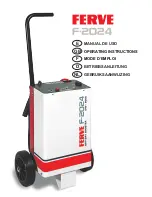
211
Car care
Note: Low tyre pressure also causes pre-
mature tyre wear and increased fuel con-
sumption.
Tyre pressure should match the current
load and speed of the car, see page 245.
The tyre pressures given apply to cold
tyres, that is they have the same tempera-
ture as the outside air temperature.
The pressure increases approximately
0.3 bar (4 psi) as the tyres become warm
(e.g. during fast motorway driving). When
the temperature of the tyres changes by
10 °C, the tyre pressure will change 0.1 bar
(2 psi).
Never reduce the pressure of a hot tyre. If
the tyres are hot when you check them, only
increase the pressure, if necessary.
Underinflated tyres wear more quickly than
slightly overinflated tyres.
If a valve is leaking, simply unscrew it and fit
a new one.
Note: Remember to adjust the tyre pres-
sures if you change the load in the car sig-
nificantly or intend to drive at substantially
lower or higher speeds than normal.
Shifting the wheels
Because the car has front-wheel drive, the
front tyres tend to wear faster than the rear
ones. New tyres should always be fitted in
pairs, so that tyres on the same axle have
the same amount of tread.
Mark the wheels L (left) and R (right) when
changing between summer and winter
tyres. This ensures that the direction of rota-
tion of the wheels is the same when they are
refitted. Fit the tyres in best condition to the
rear wheels.
Store wheels either lying flat or hanging –
never standing upright.
Tyre markings
Tyre marking 215/55 R16 93V means:
WARNING
When fitting just one new pair of tyres,
these should be fitted to the rear wheels,
as these are more critical to the direc-
tional stability of the car (e.g. on braking
or in a skid). The existing rear wheels
should therefore be moved to the front.
Always move rear left to front left and rear
right to front right, so that the direction of
rotation remains the same.
215 Tyre section width, mm
55 Aspect ratio, i.e. the section height
as a percentage of the section
width
R Radial ply
16 16 in. wheel rim diameter at bead
seats
93 Tyre load index
V Speed rating
Tyre load indices
91 Tyre approved for max. 615 kg
93 Max. 650 kg
94 Max. 670 kg
95 Max. 690 kg
97 Max. 730 kg
Speed ratings
Q Tyre approved for speeds up
to 100 mph (160 km/h)
S Max. 112 mph (180 km/h)
T Max. 118 mph (190 km/h)
H Max. 130 mph (210 km/h)
V Max. 149 mph (240 km/h)
W Max. 168 mph (270 km/h)
Y Max. 186 mph (300 km/h)
460_OM_MY09.book Page 211 Wednesday, April 2, 2008 10:32 AM
Summary of Contents for BLS
Page 14: ...14 This page has been left blank 460_OM_MY09 book Page 14 Wednesday April 2 2008 10 32 AM ...
Page 261: ...261 Notes Notes 460_OM_MY09 book Page 261 Wednesday April 2 2008 10 32 AM ...
Page 262: ...262 Notes 460_OM_MY09 book Page 262 Wednesday April 2 2008 10 32 AM ...
Page 263: ...263 Notes 460_OM_MY09 book Page 263 Wednesday April 2 2008 10 32 AM ...
Page 264: ...264 Notes 460_OM_MY09 book Page 264 Wednesday April 2 2008 10 32 AM ...
Page 265: ...265 Notes 460_OM_MY09 book Page 265 Wednesday April 2 2008 10 32 AM ...
Page 266: ...266 Notes 460_OM_MY09 book Page 266 Wednesday April 2 2008 10 32 AM ...
Page 267: ...267 Notes 460_OM_MY09 book Page 267 Wednesday April 2 2008 10 32 AM ...
Page 268: ...268 Notes 460_OM_MY09 book Page 268 Wednesday April 2 2008 10 32 AM ...
Page 269: ...269 Notes 460_OM_MY09 book Page 269 Wednesday April 2 2008 10 32 AM ...
Page 270: ...270 Notes 460_OM_MY09 book Page 270 Wednesday April 2 2008 10 32 AM ...
Page 271: ...271 Notes 460_OM_MY09 book Page 271 Wednesday April 2 2008 10 32 AM ...
Page 272: ...272 Notes 460_OM_MY09 book Page 272 Wednesday April 2 2008 10 32 AM ...
















































